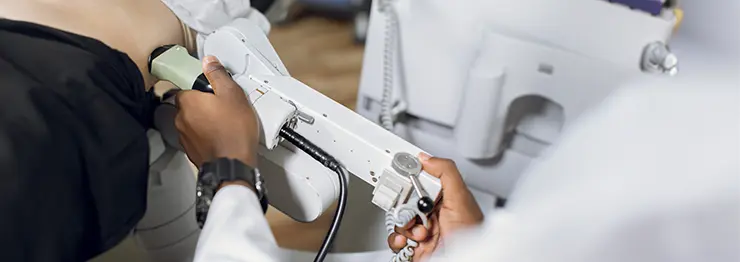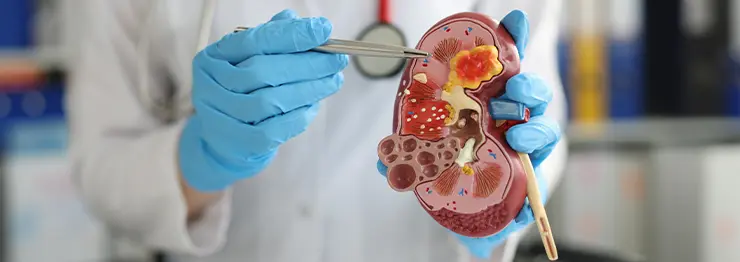Lithotripsy
All Techniques of Urethroplasty
Comprehensive Stone Disease
Partial & Radical Cystectomy
Urologic Oncology

Doctors use lithotripsy, a non-invasive procedure, to treat large kidney stones that cannot pass through the urinary tract. A machine called a lithotripter generates ultrasonic energy or shock waves. X-rays focus these waves onto the kidney stone. The waves travel through skin and tissue, reaching and breaking the stone into smaller, passable fragments, allowing for natural elimination through the urinary system without surgical intervention. This technique helps patients avoid invasive stone removal procedures.

Surgeons perform urethroplasty to replace a scarred urethra. They remove the scar tissue and reconnect the urethra's ends or use tissue from elsewhere to rebuild the blocked section. This procedure addresses urinary strictures, where a narrowed urethra blocks urine flow and causes urinary problems. The surgery aims to restore normal urinary function by creating a wider, unobstructed path for urine flow.

Crystals that form in the urinary tract, are known as kidney stones which pass through urine naturally, though painfully. Also called renal calculi or nephrolithiasis, if these stones cause blockages, doctors perform various procedures to remove them. The doctors choose the most appropriate method based on the size and location of the stone. These include lithotripsy, where shock waves break down stones; ureteroscopy, involving a small scope to remove stones; and laparoscopic surgery for larger stones.

Surgeons perform cystectomy to remove the urinary bladder. In a radical cystectomy, they remove the entire bladder along with the prostate, seminal vesicles, uterus, ovaries, fallopian tubes, and part of the vagina. Doctors typically recommend radical cystectomy to treat cancers that have invaded the bladder's muscle tissue or recurrent bladder cancer. For partial cystectomy, surgeons resect only a portion of the bladder, targeting cancerous tumours confined to one area. This procedure preserves part of the bladder while removing the affected tissue.

Urologic oncologists diagnose and treat cancers of the urinary tract and male reproductive organs, including the bladder, kidneys, prostate, penis, and testicles. They employ various techniques such as prostatectomy to remove the prostate, biopsy to examine tissue samples, transurethral resection to remove tumours through the urethra, cystectomy to remove the urinary bladder, reconstructive surgery to restore function, nephrectomy to remove kidneys, and lymph node resection to prevent cancer spread. Surgeons often combine these surgical methods with chemotherapy or radiotherapy to ensure complete cancer removal.
Lithotripsy

Doctors use lithotripsy, a non-invasive procedure, to treat large kidney stones that cannot pass through the urinary tract. A machine called a lithotripter generates ultrasonic energy or shock waves. X-rays focus these waves onto the kidney stone. The waves travel through skin and tissue, reaching and breaking the stone into smaller, passable fragments, allowing for natural elimination through the urinary system without surgical intervention. This technique helps patients avoid invasive stone removal procedures.
All Techniques of Urethroplasty

Surgeons perform urethroplasty to replace a scarred urethra. They remove the scar tissue and reconnect the urethra's ends or use tissue from elsewhere to rebuild the blocked section. This procedure addresses urinary strictures, where a narrowed urethra blocks urine flow and causes urinary problems. The surgery aims to restore normal urinary function by creating a wider, unobstructed path for urine flow.
Comprehensive Stone Disease

Crystals that form in the urinary tract, are known as kidney stones which pass through urine naturally, though painfully. Also called renal calculi or nephrolithiasis, if these stones cause blockages, doctors perform various procedures to remove them. The doctors choose the most appropriate method based on the size and location of the stone. These include lithotripsy, where shock waves break down stones; ureteroscopy, involving a small scope to remove stones; and laparoscopic surgery for larger stones.
Partial & Radical Cystectomy

Surgeons perform cystectomy to remove the urinary bladder. In a radical cystectomy, they remove the entire bladder along with the prostate, seminal vesicles, uterus, ovaries, fallopian tubes, and part of the vagina. Doctors typically recommend radical cystectomy to treat cancers that have invaded the bladder's muscle tissue or recurrent bladder cancer. For partial cystectomy, surgeons resect only a portion of the bladder, targeting cancerous tumours confined to one area. This procedure preserves part of the bladder while removing the affected tissue.
Urologic Oncology

Urologic oncologists diagnose and treat cancers of the urinary tract and male reproductive organs, including the bladder, kidneys, prostate, penis, and testicles. They employ various techniques such as prostatectomy to remove the prostate, biopsy to examine tissue samples, transurethral resection to remove tumours through the urethra, cystectomy to remove the urinary bladder, reconstructive surgery to restore function, nephrectomy to remove kidneys, and lymph node resection to prevent cancer spread. Surgeons often combine these surgical methods with chemotherapy or radiotherapy to ensure complete cancer removal.
Top specialists. Advanced technology. Exceptional healthcare.
